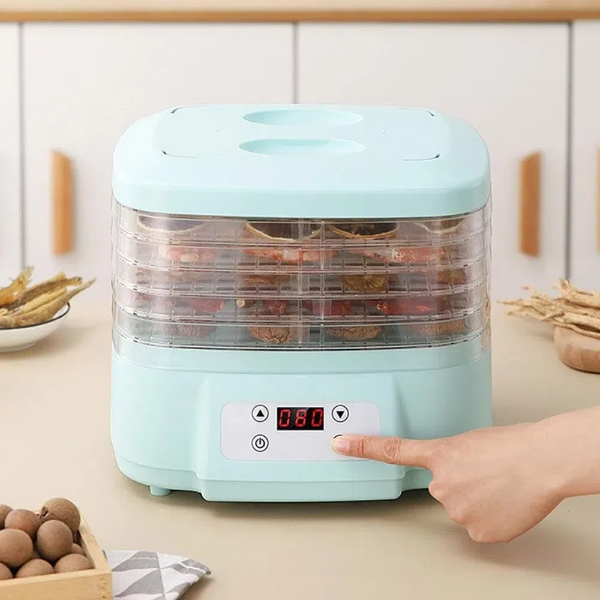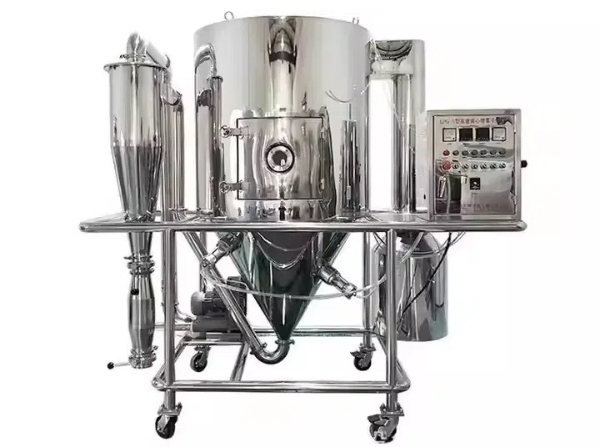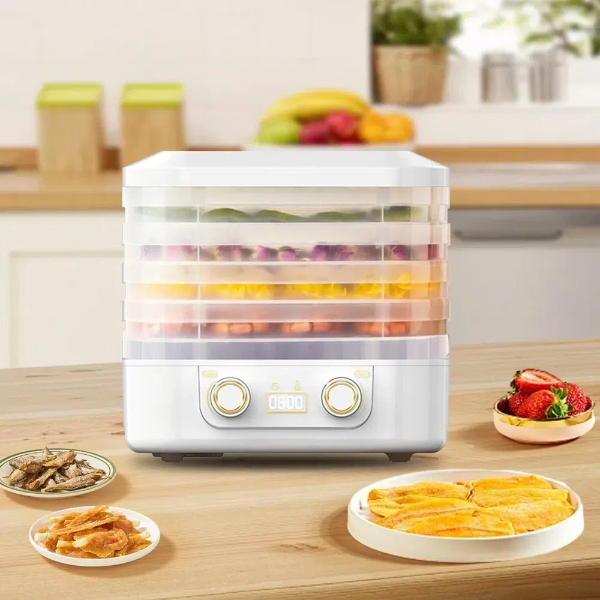
Content Menu
● Understanding Airflow Dynamics in Food Dryers
● The Impact of Airflow on Drying Efficiency
● Airflow Patterns in Food Dryers
● Achieving Optimal Airflow: Design Considerations
● Benefits of Proper Airflow Management
● Advanced Airflow Control Strategies
>> Variable Airflow Control
>> Air Recirculation
>> Airflow Reversal
>> Pulsed Airflow
● The Role of Airflow in Different Types of Food Dryers
>> Cabinet Dryers
>> Tunnel Dryers
>> Fluidized Bed Dryers
>> Spray Dryers
● Optimizing Airflow for Specific Food Products
● Conclusion
● FAQ
>> 1. What is the ideal airflow rate for drying fruits and vegetables?
>> 2. How can I measure the airflow in my food dryer?
>> 3. What are the consequences of insufficient airflow in a food dryer?
>> 4. Can airflow be too high in a food dryer?
>> 5. How does humidity affect airflow requirements in a food dryer?
● Citations:
As a Chinese food dryer manufacturing factory, we provide OEM services for foreign food dryer brand owners, wholesalers, and manufacturers. In the realm of food processing, drying stands as a critical operation, influencing the quality, safety, and shelf life of the final product. Among the various drying technologies available, food dryers play a pivotal role, and airflow management within these dryers is paramount to achieving perfect drying results. This article delves into the significance of airflow in food dryers, exploring its impact on drying efficiency, product quality, and energy consumption.

Understanding Airflow Dynamics in Food Dryers
Airflow, the rate at which air moves through the dryer, is a fundamental parameter governing the drying process. It acts as a carrier of heat, facilitating the evaporation of moisture from the food material. Moreover, airflow aids in removing the evaporated moisture, preventing saturation within the drying chamber and maintaining a consistent drying rate.
Several factors influence airflow dynamics within a food dryer:
- Dryer Design: The size and shape of the drying chamber, the arrangement of air inlets and outlets, and the presence of any internal structures all contribute to the airflow pattern.
- Air Velocity and Volume: Higher air velocities promote faster drying rates but can also lead to particle entrainment. The air volume must be sufficient to ensure complete and uniform drying without causing excessive pressure drop.
- Bed Height and Particle Size: In fluidized bed dryers, the height of the food material bed and the size of the particles affect the airflow patterns. Deeper beds or larger particles may require higher airflow rates to achieve proper fluidization.
- Moisture Content and Temperature: The initial moisture content of the food and the drying air temperature influence the airflow requirements. Wetter foods may require higher airflow rates to facilitate moisture evaporation.
The Impact of Airflow on Drying Efficiency
Optimal airflow is crucial for efficient and uniform drying. It ensures that all parts of the food material are exposed to the drying air, preventing localized over-drying or under-drying. By maintaining the right airflow, drying times can be minimized, leading to improved productivity and reduced energy consumption.
Inadequate airflow can result in several detrimental effects:
- Uneven Drying: Insufficient airflow can lead to some areas of the food material drying faster than others, resulting in inconsistent moisture content and quality.
- Prolonged Drying Times: Reduced airflow slows down the evaporation and removal of moisture, extending the drying process and increasing energy consumption.
- Increased Risk of Spoilage: Inadequate airflow can create stagnant zones within the dryer, promoting microbial growth and spoilage.
Airflow Patterns in Food Dryers
Different airflow patterns are employed in food dryers, each with its advantages and considerations:
- Upward Airflow: Air is introduced from the bottom of the dryer and flows upward through the food material. This pattern provides excellent mixing and is suitable for drying heat-sensitive materials.
- Downward Airflow: Air is introduced from the top of the dryer and flows downward through the food material. This pattern offers better control over the drying process and is advantageous for applications requiring precision.
- Crossflow: Air flows horizontally across the food material. This pattern is commonly used in tunnel dryers and is suitable for continuous drying operations.
The selection of the appropriate airflow pattern depends on factors such as the nature of the food material, the desired drying rate, and the product quality requirements.
Achieving Optimal Airflow: Design Considerations
To achieve optimal airflow in food dryers, several design considerations should be taken into account:
- Uniform Airflow Distribution: Proper distribution plates, air distribution systems, and chamber design contribute to achieving uniform airflow throughout the dryer.
- Airflow Control: Implementing airflow control mechanisms, such as variable speed fans and dampers, allows for adjusting the airflow rate based on the specific drying requirements.
- Sealing: Proper sealing of the dryer prevents air leakage, ensuring that the airflow is directed through the food material.
- Monitoring and Adjustment: Real-time monitoring of airflow parameters, such as velocity and pressure, enables operators to make necessary adjustments to maintain optimal drying conditions.
Benefits of Proper Airflow Management
Proper airflow management in food dryers offers numerous benefits:
- Improved Product Quality: Consistent and uniform drying ensures that the food material meets the desired quality attributes, such as moisture content, color, and texture.
- Enhanced Food Safety: Adequate airflow prevents the growth of microorganisms, reducing the risk of spoilage and ensuring food safety.
- Reduced Energy Consumption: Optimized airflow minimizes drying times and energy usage, leading to cost savings and environmental sustainability.
- Increased Productivity: Efficient drying processes translate to higher throughput and increased productivity.
Advanced Airflow Control Strategies
Beyond the basic design considerations, advanced airflow control strategies can further optimize the drying process and enhance product quality. These strategies often involve sophisticated sensors, control algorithms, and automation systems.
Variable Airflow Control
Variable airflow control involves adjusting the airflow rate throughout the drying process based on real-time measurements of moisture content, temperature, and humidity. This approach allows for tailoring the drying conditions to the specific needs of the food material, ensuring optimal drying rates and minimizing energy consumption.
For example, during the initial stages of drying, when the moisture content is high, a higher airflow rate may be necessary to facilitate rapid moisture evaporation. As the moisture content decreases, the airflow rate can be reduced to prevent over-drying and conserve energy.
Air Recirculation
Air recirculation involves partially or fully recirculating the exhaust air back into the dryer. This strategy can significantly reduce energy consumption by recovering the heat from the exhaust air and reducing the amount of fresh air that needs to be heated.
However, air recirculation also has some potential drawbacks. The recirculated air may contain high levels of humidity, which can reduce the drying capacity of the air. Additionally, the recirculated air may contain contaminants that can affect the quality and safety of the food material. Therefore, proper filtration and monitoring are essential when implementing air recirculation.

Airflow Reversal
Airflow reversal involves periodically reversing the direction of airflow through the dryer. This strategy can improve the uniformity of drying by ensuring that all parts of the food material are exposed to the drying air. Airflow reversal is particularly effective in dryers with deep beds or complex geometries where airflow distribution may be uneven.
Pulsed Airflow
Pulsed airflow involves intermittently turning the airflow on and off. This strategy can improve the drying rate and energy efficiency by creating a more turbulent airflow pattern that enhances heat and mass transfer. Pulsed airflow can also reduce the risk of case hardening, which is a phenomenon where the surface of the food material dries too quickly, forming a hard crust that prevents moisture from escaping from the interior.
The Role of Airflow in Different Types of Food Dryers
The optimal airflow management strategy depends on the type of food dryer being used. Here's a brief overview of the role of airflow in some common types of food dryers:
Cabinet Dryers
Cabinet dryers are batch dryers that consist of an insulated cabinet with trays for holding the food material. Air is circulated through the cabinet by a fan, and the temperature and humidity are controlled to achieve the desired drying rate. Airflow is important in cabinet dryers to ensure uniform drying and prevent the formation of hot spots.
Tunnel Dryers
Tunnel dryers are continuous dryers that consist of a long tunnel through which the food material is conveyed on trays or belts. Air is circulated through the tunnel, and the temperature and humidity are controlled to achieve the desired drying rate. Airflow is important in tunnel dryers to ensure uniform drying and to remove moisture from the food material as it moves through the tunnel.
Fluidized Bed Dryers
Fluidized bed dryers are continuous dryers that use a stream of air to suspend the food material in a fluidized state. This allows for rapid and uniform drying. Airflow is critical in fluidized bed dryers to maintain the fluidization of the food material and to provide good heat and mass transfer.
Spray Dryers
Spray dryers are continuous dryers that atomize a liquid food material into a spray of fine droplets and then dry the droplets in a stream of hot air. Airflow is important in spray dryers to evaporate the moisture from the droplets and to carry the dried particles out of the dryer.
Optimizing Airflow for Specific Food Products
The optimal airflow management strategy also depends on the specific food product being dried. Different food products have different moisture contents, shapes, and sizes, and they require different drying conditions to achieve the desired quality and safety.
For example, fruits and vegetables typically have high moisture contents and require relatively high airflow rates to facilitate rapid moisture evaporation. Meats and fish typically have lower moisture contents and require lower airflow rates to prevent over-drying.
Small particles, such as powders and granules, are easily entrained by high airflow rates and require lower airflow rates to prevent product loss. Large pieces of food material may require higher airflow rates to ensure uniform drying.
Conclusion
In conclusion, airflow plays a critical role in achieving perfect drying results in food dryers. Proper airflow management ensures efficient and uniform drying, enhances product quality and food safety, reduces energy consumption, and increases productivity. By understanding the principles of airflow dynamics and implementing appropriate design considerations, food processors can optimize their drying operations and achieve consistent, high-quality products. Advanced control strategies, such as variable airflow control, air recirculation, airflow reversal, and pulsed airflow, can further enhance the drying process. The optimal airflow management strategy depends on the type of food dryer being used and the specific food product being dried.

FAQ
1. What is the ideal airflow rate for drying fruits and vegetables?
The ideal airflow rate depends on the specific type of fruit or vegetable, its initial moisture content, and the dryer design. However, a general guideline is to maintain an airflow rate that ensures uniform drying without causing excessive particle entrainment.
2. How can I measure the airflow in my food dryer?
Airflow can be measured using various instruments, such as anemometers and pitot tubes. These devices provide readings of air velocity, which can be used to calculate the airflow rate.
3. What are the consequences of insufficient airflow in a food dryer?
Insufficient airflow can lead to uneven drying, prolonged drying times, increased risk of spoilage, and reduced product quality.
4. Can airflow be too high in a food dryer?
Yes, excessive airflow can cause particle entrainment, leading to product loss and potential damage to the dryer components. It can also result in higher energy consumption without significantly improving the drying rate.
5. How does humidity affect airflow requirements in a food dryer?
High humidity in the drying air reduces its capacity to absorb moisture from the food material. In such cases, higher airflow rates may be necessary to compensate for the reduced drying potential.
Citations:
[1] https://www.hywellco.com/Understanding-the-Airflow-in-Fluid-Bed-Dryers-id47897727.html
[2] https://www.plasticstoday.com/plastics-processing/the-low-down-on-dryer-airflow
[3] https://patents.google.com/patent/CN110207480A/zh
[4] https://www.tandfonline.com/doi/abs/10.1080/07373937.2021.2002355
[5] https://rmigsolutions.com/applications/air-flow/
[6] https://patents.google.com/patent/WO2022068971A1/zh
[7]https://www.researchgate.net/publication/351800489_The_Application_of_a_Data_Acquisition_System_and_Airflow_Control_System_in_an_Air_Dehumidified_Drying_Machine











